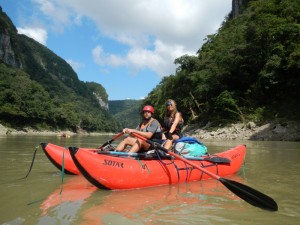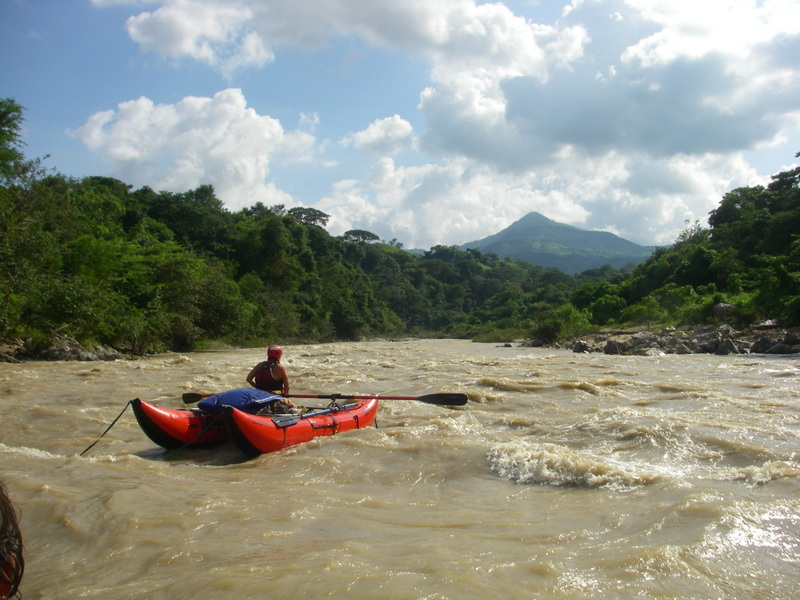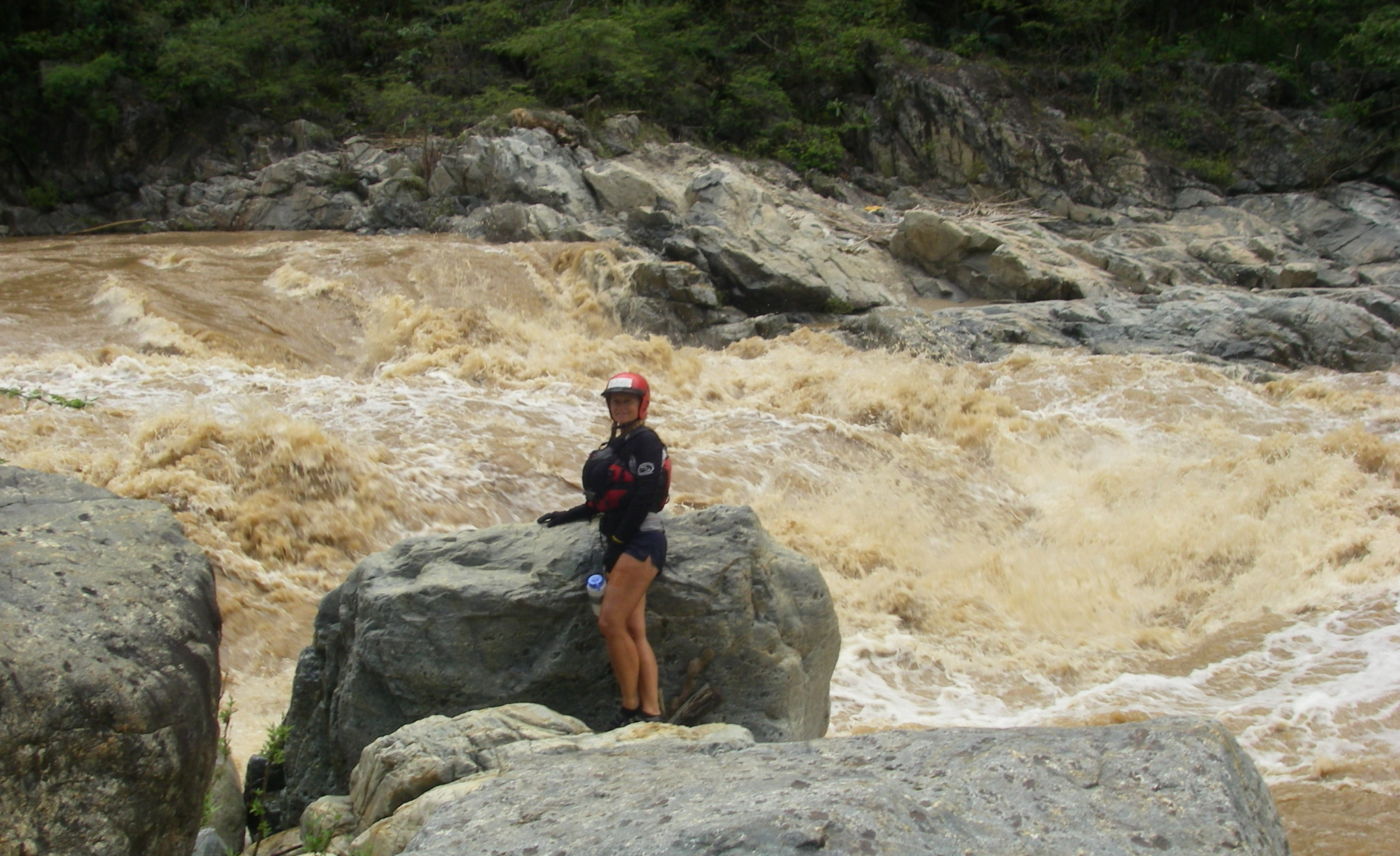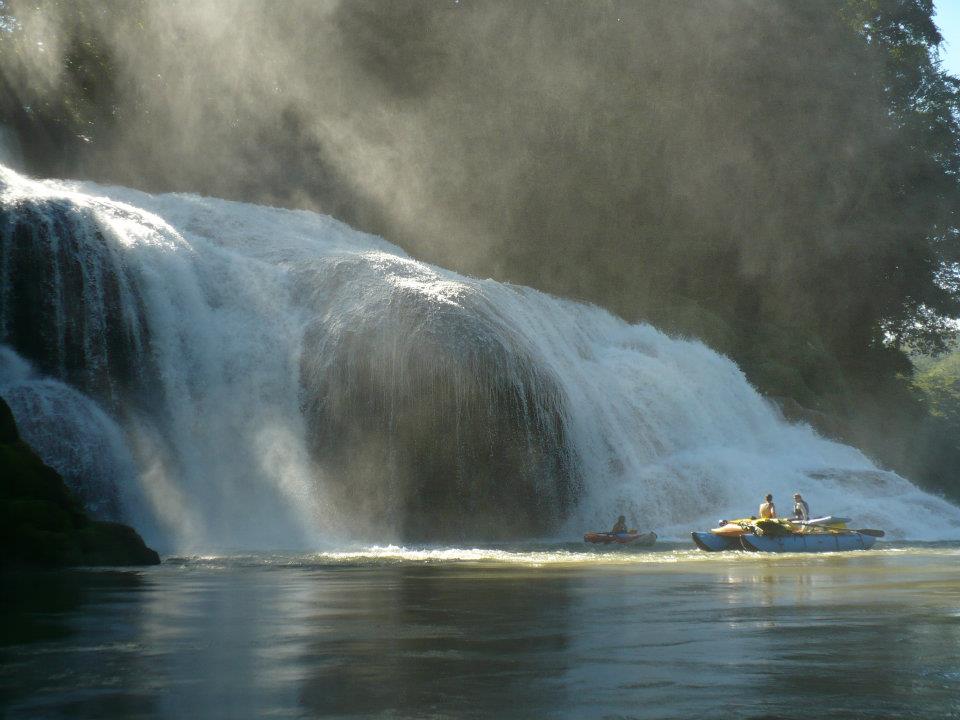Lacey Anderson ran 18 Mexican rivers in 2011, many of them first or second descents. In Part III of her Mexico whitewater adventures series, the longtime guide and author of the Camp Cooking WITHOUT Coolers cookbook talks about the thrill of scouting gnarly rapids from her boat.
It was impossible to stop for a scout at the top of Unscathed Rapid on the Mulatos River. We had to scout from our boats at the entrance into the rapid. The top section of the Class IV rapid had many flipper waves, and just when I made it through the tough upper section, I went careening into a blind right-hand turn to see many more tricky maneuvers just split seconds ahead. Running rapids without scouting beforehand was an awesome test of my whitewater abilities. Here I was in month four of a nine-month boating odyssey (see Part I and Part II), and I had learned to love the thrill of dropping into big gnarly rapids without knowing what lay ahead.
My journey began as a western U.S. whitewater river circuit, continued into Mexico for multiple first descents, and capped off in Guatemala with a hostile hostage situation. The adventure started out in May 2011 in northern California for the Smith and Cal Salmon. We then traveled to Oregon for the Rogue and Owyhee, continued into Idaho to do the Payette and Boise, and moseyed over to Colorado for the Cache La Poudre and the Arkansas. Next, we joined a group in Utah for the Green and completed the U.S. circuit in Arizona with a 16-day Grand Canyon trip. Over those four months, my boating skills improved drastically, and I discovered I most enjoyed testing my read and run skills.
I continued on this remarkable journey by crossing the border into Mexico in my trusty 4×4 Toyota Tundra with a camper full of boating equipment. Inside the camper were two small catarafts, one 16’ cataraft, 11 oars, and all the equipment needed to run multiday trips. The camper roof rack held the large cataraft’s frame and two kayaks. The back bumper had a rack for the two small cataraft frames.

In Mexico, I met up with kayak explorer Rocky Contos. Rocky has been running first descents in Mexico for the last 13 years and has written the guidebook, Mexican Whitewater: Norte. We began our Mexico river circuit in the northern state of Sonora and ended in the southern state of Oaxaca. I boated over 18 rivers in Mexico, 12 of which were with Rocky, including lots of first and second descents. Most, such as the Baluarte, Tlaplaneco-Mezcala, Atotonilco-Santa Catarina and the Atoyac, had never been boated. Astoundingly, the majority of these rivers were multiday expeditions ranging from 3 to 11 days.
Remembering the Mulatos River, few rapids compare to the adrenalin rush of Dos Arroyos. It took intense focus and constant alertness as I was suddenly pulled into this long rapid unable to see the bottom. During the top section of the rapid, I would shoot out of one big wave and be tossed right in line to smash into a rock, wave or hole. It took constant action on the oars to stay upright. At the lower section of the rapid, my cataraft was pulled by the swift current, aimed directly for a humungous pour-over. I pulled on the oars with all my might, just missing the rock as my left tube was yanked into the steep drop created by the enormous rock. At the water levels we had, the river was continuous Class IV read-and-run fun!

One of the highlights of my journey was coaching the blind adventurer Erik Weihenmayer on the Usumacinta River. He is in training to be the first blind person to kayak the Colorado River through the Grand Canyon. On the last day of the Usumacinta trip, I was honored to be asked to coach Erik through some of the big water (80,000 cfs) Class III rapids. I positioned myself behind Erik, sitting on top of gear, with Erik in control of my cataraft.
Directing him through the turbulent water reminded me of being a paddle boat captain, using similar commands. To make a right turn, I suggested “right back, left forward, right back, left forward.” Erik quickly got the boat turned. As we approached boat-eating whirlpools, I verbally prepared and directed him, “about to hit a whirlpool, brace, hard forward, give it your all, push with both arms, hard forward.” The rapids were big enough to flip us, but Erik’s determination, strength and ability to quickly and perfectly follow commands kept us upright.

Probably the most challenging whitewater occurred during our multiday first descent on the Atoyac River in the state of Oaxaca. Unable to scout several rapids and with nowhere to portage my cataraft, I nervously rowed into the whitewater. The majority of the run turned into pure bliss as I crashed through multiple big drops with the occasional unintended surf. Fortunately, there was an eddy at the top of the last big rapid, so we pulled over to shore and hopped out for a quick peek. “No problem,” I thought to myself.
As I smoothly made a boof off of a rock, lined up for the turn – whoops – the cataraft plopped into a deep reversal, not a mild wave. At that moment, I realized I should have scouted the bottom of the rapid, not just the top! Suddenly my boat was on top of me, I was upside down with my head and entire body deep underwater in the hole. I was about to swim when unexpectedly the boat flipped back over. I found myself upright, still seated on the frame, entire body soaking wet, hands still clenched to the oars. I began laughing with delight. I had expected to swim, but the boat had other ideas – it performed a sideways cartwheel! These river tales are a small sampling of the astounding adventure I had and the remarkable people I met along the way.
I am the author of Camp Cooking WITHOUT Coolers II. The recipes in my cookbook work well for any camp kitchen but are especially suited for international journeys or long-lasting expeditions because no ice is needed! It can be difficult to find quality ice (ice that will last longer than a day or two) in developing countries. I have guided rafters and backpackers all over the West and in Mexico. This wealth of experience has given me a unique perspective on tasty meal planning. For more information, please see the website www.nocoolers.com or order the cookbook through NRS. Here’s one of the recipes out of my Camp Cooking WITHOUT Cooler II cookbook.
Bliss Balls (makes about 2 dozen bite-sized pieces)
1 cup peanut butter
½ cup instant milk powder
½ cup raisins
2 tablespoons brown sugar
2 tablespoons honey
2 tablespoons sunflower seeds
5 tablespoons semi-sweet chocolate chips
Outside coating for balls:
½ cup crushed graham crackers (2 squares)
2 tablespoons NIDO (dry whole milk powder)
2 tablespoons chia seeds
Make the coating:
Place crushed graham crackers, milk powder and chia seeds into a freezer bag and mix thoroughly.
Make the balls:
- Mix all ingredients for the balls. Stir completely until all ingredients are evenly mixed.
- Roll into teaspoon-size balls, if you do not have a teaspoon, think of the size of Milk Duds. It is better to make them smaller rather than larger and this will make about 2 dozen.
- Drop balls one by one into the freezer bag of coating mixture, and roll around to evenly coat the outside of balls. Remove from bag, and set aside.
- Once balls are all made and coated, place the balls back into coating mixture and serve. If there are any left over (unlikely!), store them in the baggie and serve later. The coating helps to keep them from sticking to each other.




